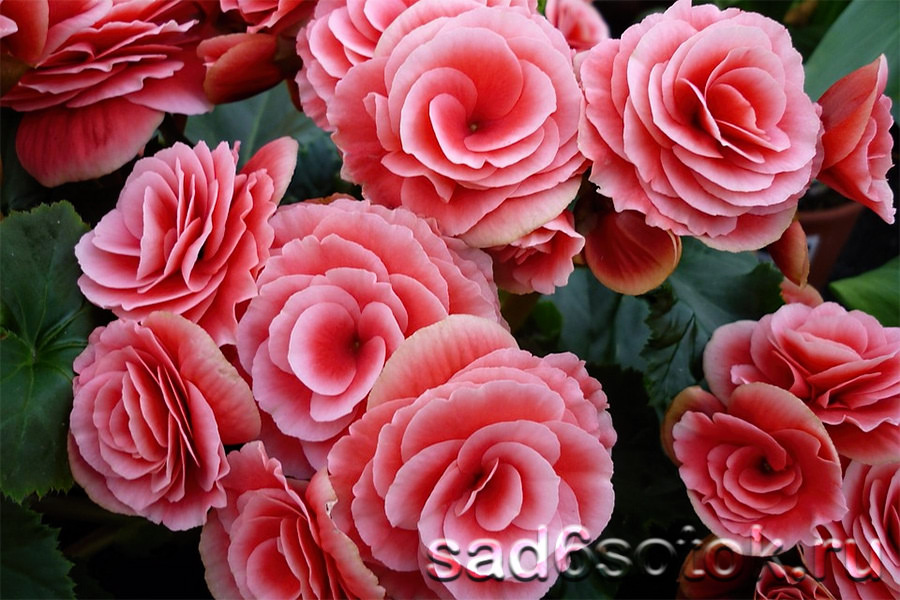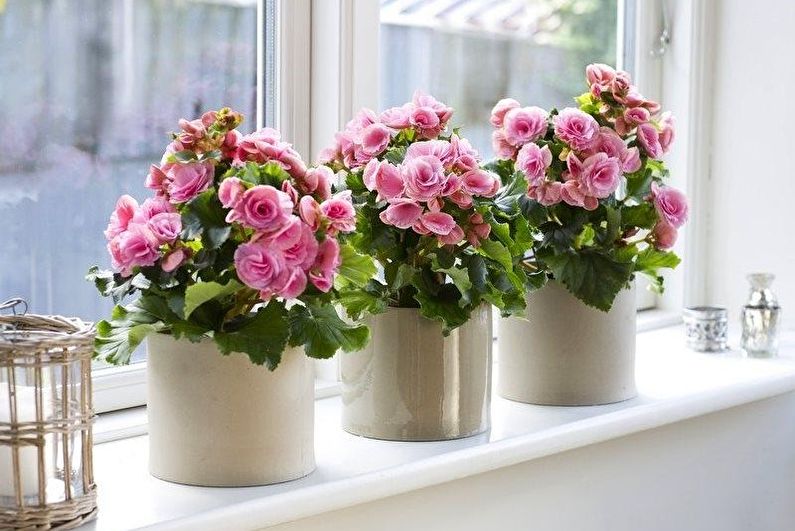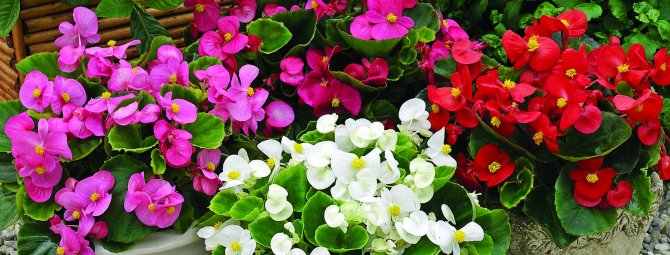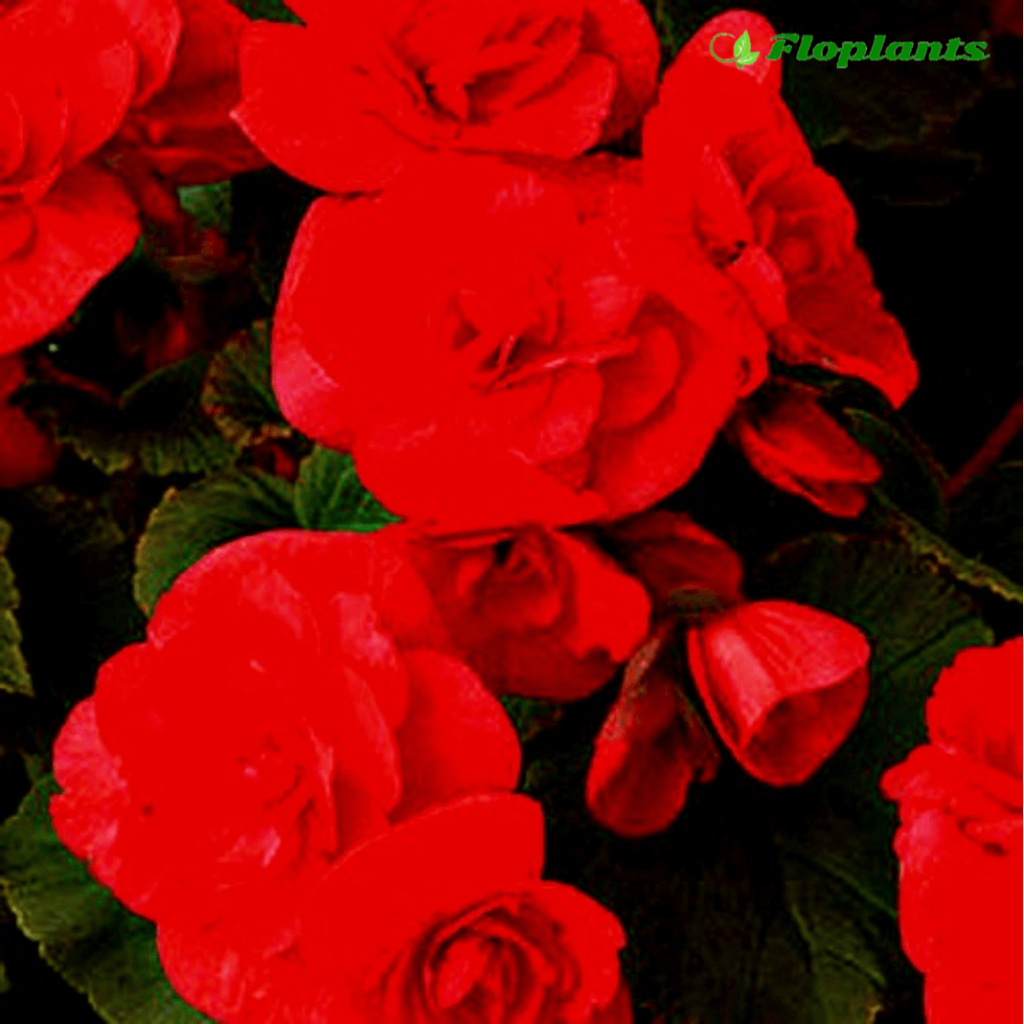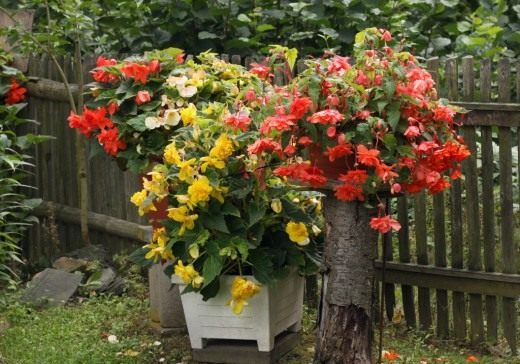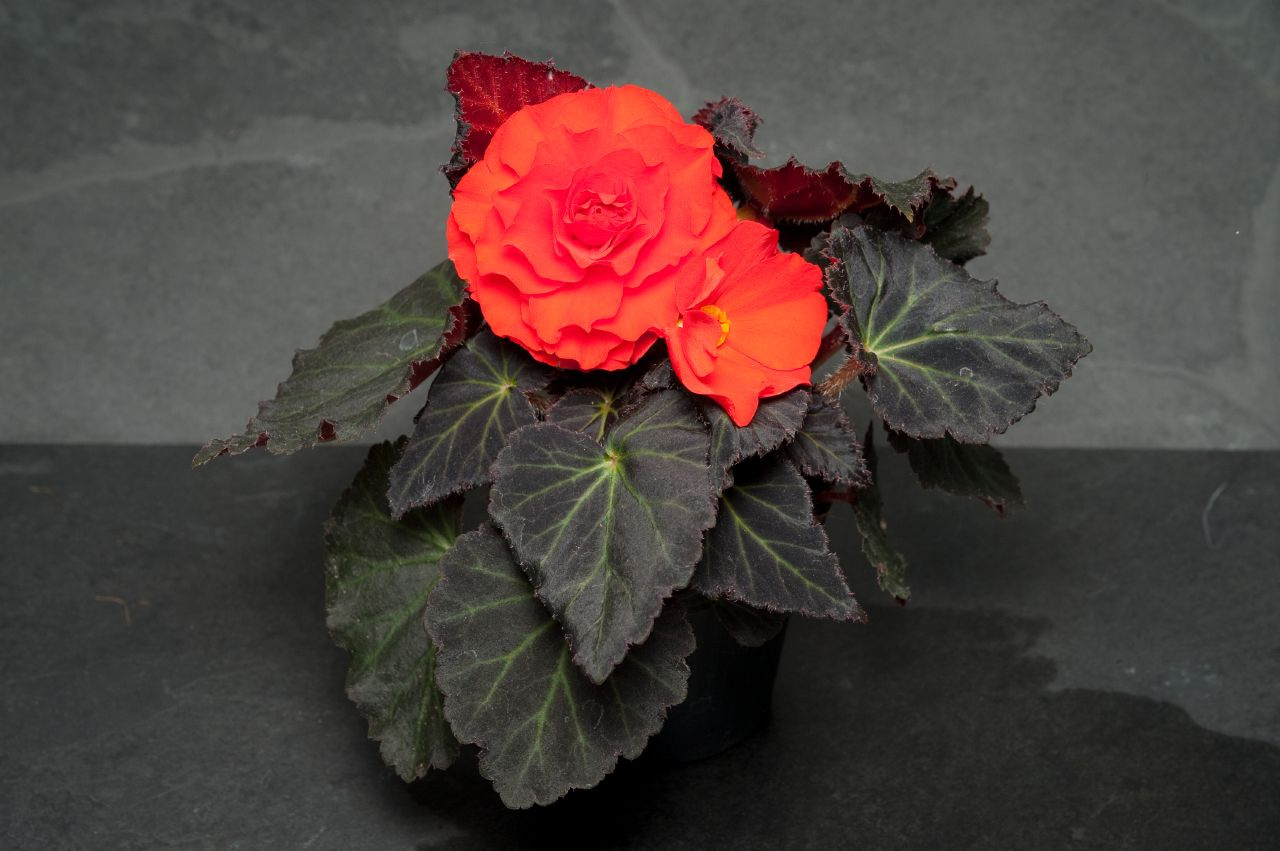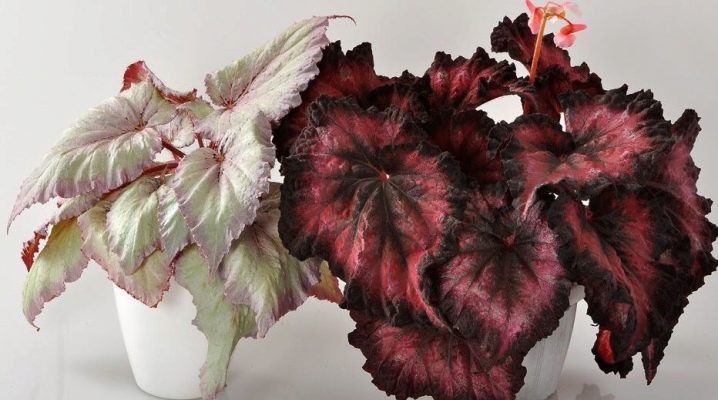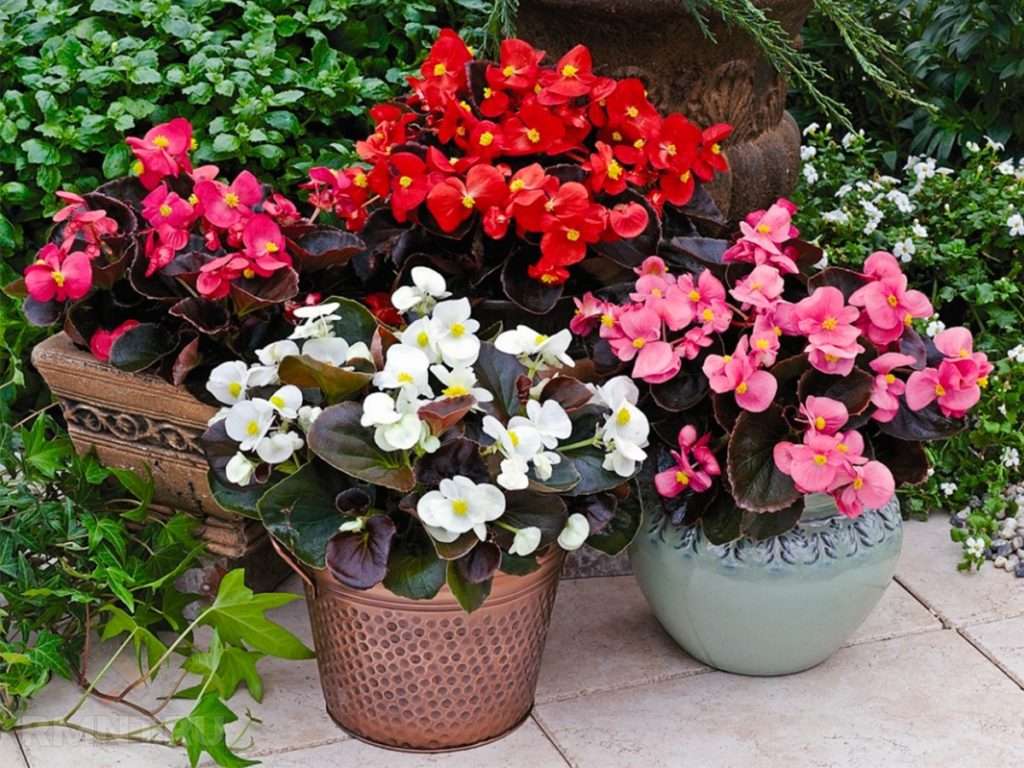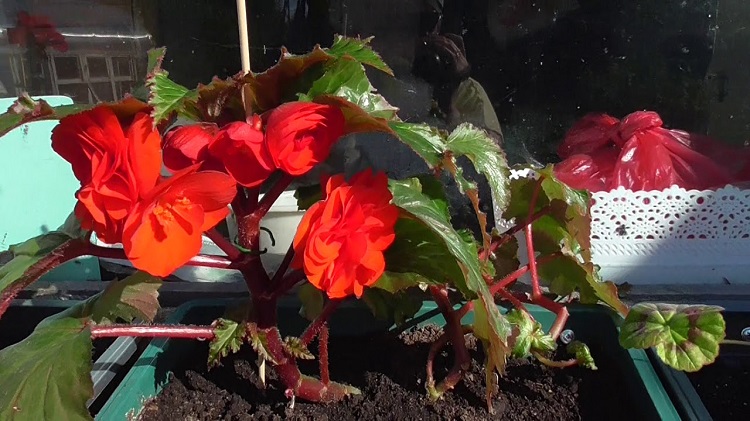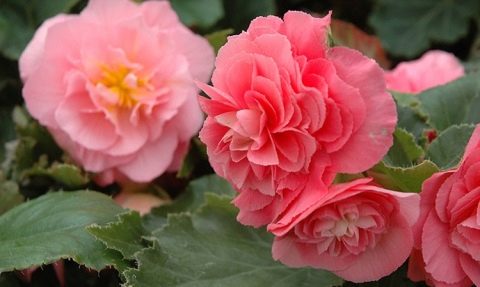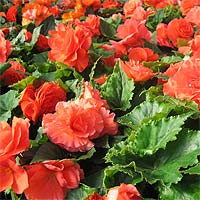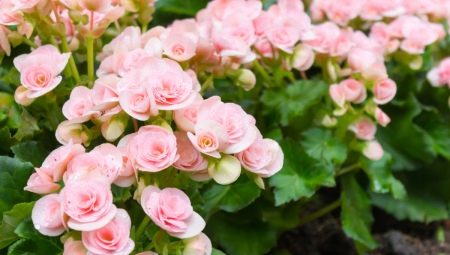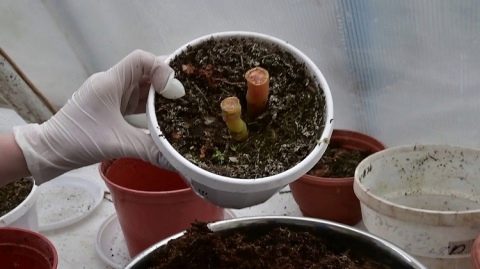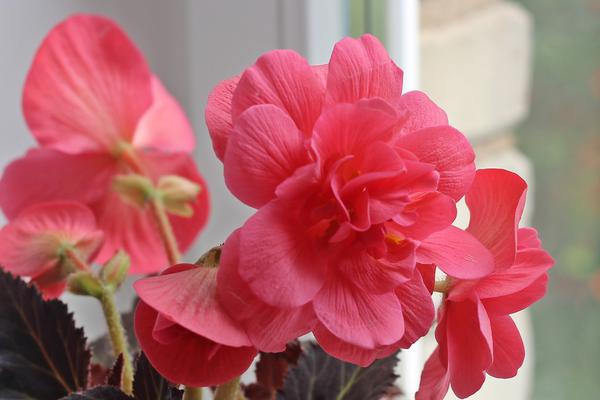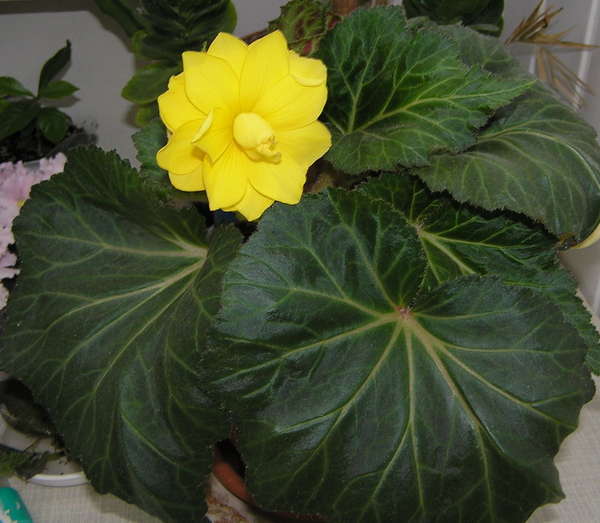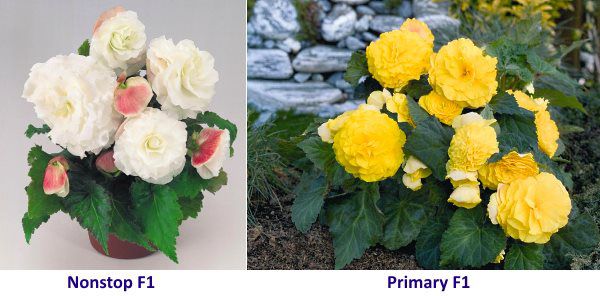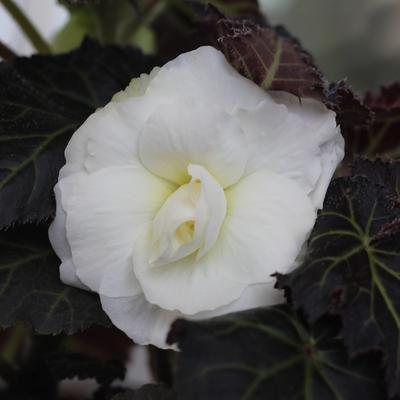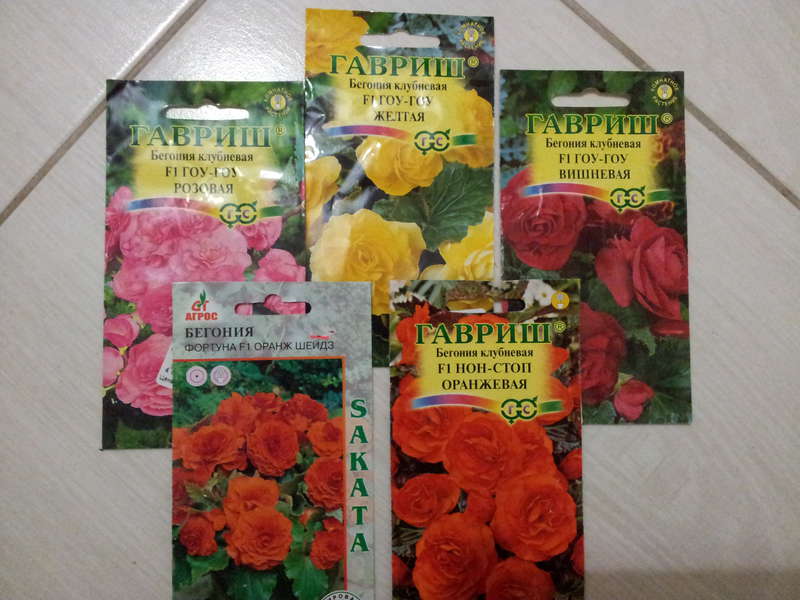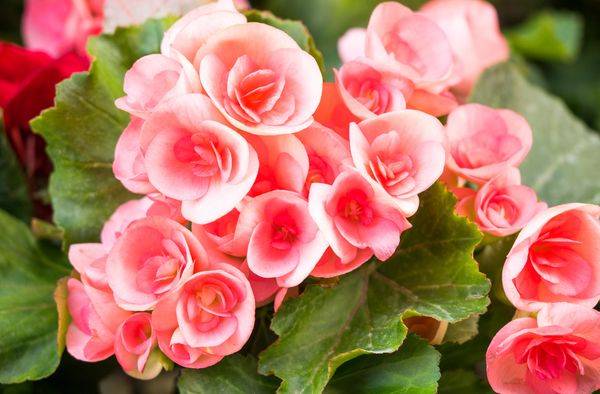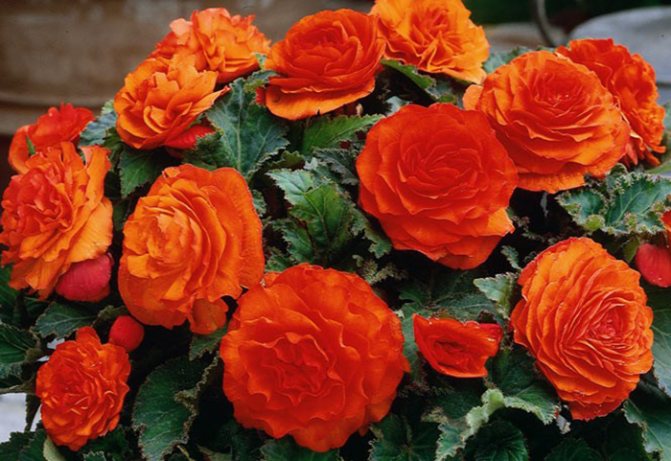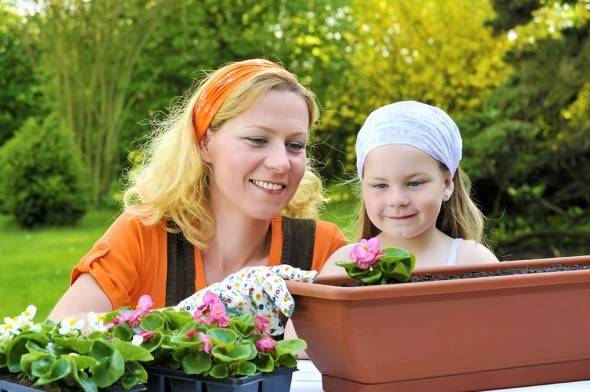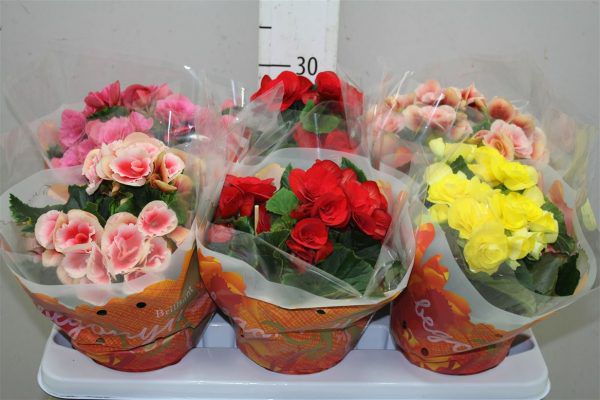Tuberous large-flowered begonia and its hybrids
Begonia tuberhybrida is the most popular and unpretentious of the flowering forms, with large and beautiful flowers. Queen of the Summer Shadow (Summer Shade Queen) - so called B. x tuberhybrida (B. tuber hybrid). Most of the sales of begonias come from this group.
- Classification of begonias by groups
- Group of ornamental begonias
- Planting tuberous begonias and care
Tuberous begonia includes tuberous begonia (b.tuberhybrida), multiflorous begonia (b.multiflora), tuberous begonia (b.tuberhubrida pendula) with hanging stems. Cultivation of tuberous begonias in Europe began in 1760 from wild forms brought from Brazil.
The first terry forms were created in 1867-1870. in Belgium by the famous breeder Louis Van Gutt. This country is still the main producer of begonia in Europe, where up to 100 million tubers are produced. The hybrids familiar to us were obtained in 1870. The original species of begonias were rather plain, but in a short time the plant was transformed. Skilled gardeners bred noble varieties of tuberous begonias with a short but strong stem, varied leaves and erect flowers.
The selection of tuberous begonias proceeded very quickly, since the hybrids gave a lot of seeds, and the original species were distinguished by a great variety in the shape and color of the flower. In a relatively short period of time, hybrids with all characteristic colors and double flowers went on sale. Further selection led to the creation of garden groups with flowers of various sizes: giant (gigantea) - up to 20 cm, large-flowered (grandiflora) - with flowers, the diameter of which is 8-10 cm, profusely flowering (floribunda) - 8-12 cm and multiflora (multiflora ) - 5-7 cm in diameter.
Currently, all tuberous begonias can be divided into groups:
- small-flowered - double and simple;
- mid-flowered - terry;
- large-flowered - terry.
The most common varieties of large-flowered begonia (B. tuberhybrida), the flowers of which are similar to those of a rose or camellia and reach 5-15 cm in diameter. When buying, you should give preference to plants with unblown buds, without spots on the leaves. If you buy tubers, then you should choose small, dense, elastic, without brown spots.
Unlike other begonias, they are annual herbaceous plants with a translucent fleshy stem and a thick underground tuber. One tuber grows up to seven stems 30-70 cm high. Leaves 10-30 cm long, cordate or kidney-shaped, more or less fleshy, sometimes covered with fluff or corrugated, often spotted or marbled, falling off in winter. Tuberous begonia flowers of various colors, double, semi-double and non-double, in the form of an anemone or in the form of an inflorescence, dioecious: male - larger, female - smaller. In color, the flowers are dark red, burgundy, red, orange, pink, yellow, cream, white. Flowering lasts from May to October.
Hybrids of tuberous begonias are monochromatic:
- Sugar Candy (pale pink)
- Gold Plate (yellow);
- Guardsman (red);
- Diana Wynward (white).
Shapes with a border around the edge of the petals:
- Seville (yellow with pink border);
- Double Picotee (cream with red border).
The soil
The soil of begonias love loose, light, water and moisture permeable, with a neutral or slightly acidic reaction. We recommend buying it from a store. Look for a special blend for Begonia. If you are a fan of self-preparation of substrates for plants, prepare a mixture of the following composition for begonia: 3 hours of leaf soil, peat, humus and coarse sand for 1 hour. Drainage (expanded clay, pebbles with coarse sand or perlite) lay in a layer in a third of the pot. Add small pieces of charcoal there (for the prevention of fungal diseases) in a layer of 2-3 cm. Now you can pour part of the prepared substrate.We remind you that self-prepared soil should be disinfected before use (steamed, frozen or spilled with hot potassium permanganate).
Begonias - flowers for apartments, gardens and offices
As an ornamental crop, begonia has been developing since 1856, when breeders began to create its hybrids. Tuberous large-flowering varieties have appeared, the most famous are bred in Belgium. Keeping these plants at home is not too difficult, otherwise they would not be so popular. Begonias are grown in the open field and on window sills, they are used for landscaping living quarters and offices, in compositions and separately. Flowers are planted in baskets and pots to decorate walls, furniture, and are also used as ground cover plants. The ever-flowering varieties are suitable for any flower garden, even carpet. Tuberous varieties are grown on balconies, verandas, in closed courtyards.
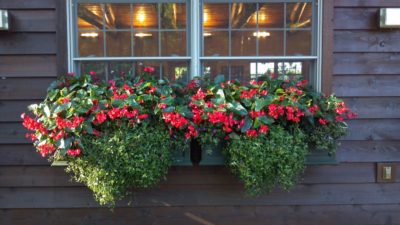
Begonia as a decoration of buildings
Home care has its own nuances, for example, tuberous need a period of rest. All begonias love humid air, but cannot tolerate damp soil. However, any novice florist can grow this plant. After all, if something went wrong, and the begonia began to dry out, you can take a stalk or leaf and start growing the begonia again, taking into account past mistakes. The culture is able to reproduce even with a piece of leaf, which very quickly turns back into a lush and beautiful houseplant.
Description

Domestic begonias belong to the Begonia genus, in which there are more than one thousand natural species, and there are many more varieties and hybrids. It is believed that the birthplace of begonia is West Africa, where it was first found in the tropical and subtropical regions of the Amazon basin in Brazil, in the central part of Africa, as well as in the countries of Southeast Asia and Indochina. The genus Begoniae combines herbaceous plants, lianas, shrubs, shrubs, as well as epiphytes growing on trees. In nature, the flower grows in places with diffused lighting, high humidity, on loose, slightly acidic soils. It easily withstands high temperatures, but does not tolerate excessive soil moisture.
Begonias are both annual and perennial. Shrubs often have erect stems, less often - climbing. Semi-shrubs are found with a thickened tuberous rhizome, with a creeping rhizome or with a tuber. By the way, tuberous species can be grown in the garden, and the rest - only indoors. Begonia leaves are usually asymmetrical. A thick vein, usually well defined, divides the leaf surface into two unequal parts. But this asymmetry only emphasizes the originality of the texture and shade. Leaves are dull or waxy, satin or velvety, very beautiful (especially in hybrids). In shades, sometimes there are silvery, bronze and even golden notes.
The flowers of the plant are irregular, mostly unisexual, monoecious. The brightly colored tepals are unequal, and the fruit is a capsule.
Possible difficulties
Powdery mildew and gray rot can occur both outdoors and indoors. Powdery mildew appears in hot, humid conditions. Gray rot - more common in cold, damp weather. In both cases, it is necessary to remove diseased leaves and increase ventilation. In case of severe damage to the plant, it should be sprayed with special preparations.
The plant is stretched due to a lack of light and nutrients, or because of a too tight container.
When dry or waterlogged, the earthen coma is affected by powdery mildew.
In cold and damp conditions, gray mold can appear - ventilation needs to be improved.
When damaged by leaf rot, its plaque and brown spots appear on the leaves (you need to remove the damaged parts and treat the plant with a fungicide solution).
Excessively damp and cold contents can cause root rot, as well as leaf spot when exposed to water.
Yellowing of the leaves is observed with a lack of light;
Brown, paper-like edges of the leaves indicate dry air or direct sunlight hitting the plant.
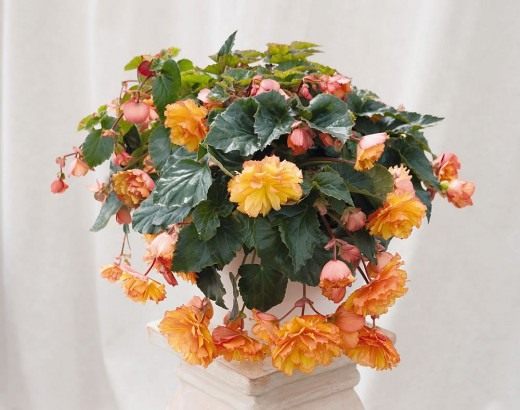
If the temperature is too high and the humidity is too low, plant leaves dry and curl.
In low light (if the shoot is too stretched), dry air (if the leaves are shriveled), excess moisture (i.e., the leaves began to droop), leaves may fall off.
With too dry air, lack of moisture or sudden temperature fluctuations, flower buds dry out.
In case of insufficient air humidity, buds may fall off.
Reproduction of begonias
Tuberous begonias do not give children, like gladioli, so they are propagated by dividing the tuber, seeds or axillary cuttings.
DIVISION BY CHERENKO. In summer, a cutting is broken out of the leaf axils and placed in boiled water. When the roots appear, the cutting is planted in the ground and covered with a jar or bottle. Then these plants are grown in the winter on the south window. In the spring they can be planted in open ground. During the summer, a small nodule is formed.
SEED REPRODUCTION. Sowing seeds requires leaf humus, peat and sand (2: 1: 1). Sow in small bowls in December-January. Since the seeds are very small, they are sown in the snow (a thin layer of snow is poured into a bowl, the sown seeds are very clearly visible on it) at a temperature of 20-27 degrees and covered with glass.
Seedlings appear in 12-14 days. The glass is opened gradually. Watering with warm (30 degrees) water from the pallet. No need to spray. Carry out a pick three times. The first pick is carried out at the stage of 2-3 leaves at a distance of 3x3 cm, watering with a 1-2% solution of potassium permanganate, the temperature should be 16-18 degrees.
A month later, a second pick is carried out, transplanting into a more nutritious soil, (0.5 buckets of manure and 1 tablespoon of mineral fertilizer), a distance of 6x6 cm.
Two weeks after the second pick, every 7-10 days they are fed with mullein solution (1:10) or bird droppings (1:20), adding 1 tbsp. a spoonful of potassium nitrate in a bucket of water.
The third pick is carried out in April-May, one plant per pot. Further, the care is the same as for tuberous begonias. Planting in the ground - in mid-June, and to improve root formation from 6 pm to 9 am, the plant is shaded, giving it a short daylight hours.
These begonias can be used as annuals, and in winter they need to be stored only in pots, cutting off the green part of the plants in September-October.
DIVISION OF CLUBS. For division, tubers with well-developed sprouts are chosen and divided into such a number of parts so that there are 1-2 sprouts on each division. Sections are dried for 1-2 hours, powdered with charcoal and planted. The division of tubers contributes to the rejuvenation of begonias, after division they bloom beautifully.
Good luck and good luck!
Hope was with you!
Landing
If you buy begonia tubers from a flower shop, be careful not to pick out damaged ones. Do not use bulbs that are soft, wrinkled, or stained in any way.
It is recommended to choose specimens that are dense, with already awakened buds. But if the bud has already turned into a stalk, you should not take it.
Kidneyless tubers can be soaked in a wet towel or bag of wet sawdust for a few days. Or place it in a solution of "Zircon" for a day, and then plant it in the ground.
The timing of planting begonias is not strictly defined. Remember that the interval between planting the tubers and flowering will be about three months, and start from this figure.
The optimal time for disembarkation is considered to be early spring, namely March-April.
Before planting tubers, they must be disinfected in order to prevent the likelihood of plant diseases. To do this, the tubers are immersed in a solution of potassium permanganate or soaked in phytosporin.
To know how to plant a tuber correctly, you need to determine where its notch is - it should be looking up. Water so as not to hit the tuber, otherwise it has no risk of rotting. Germinate plants in a warm place, spray them periodically to maintain proper moisture, but do not overdo it. A little time will pass - and the planted squad of green pets will grow together.
Home care
So, we got acquainted with the variety of varieties of tuberous begonia, learned how to plant it correctly, and now we need to find out what kind of care it needs at home.
- As soon as the plant blooms, switch to moderate watering.
- It is worth watering only after the soil has completely dried out in order to avoid rotting tubers. It is optimal to keep the soil slightly moist. Use drainage systems, humidify the air with an additional water tank or special air humidifiers.
- This flower loves light, but does not like direct sunlight.
- Fertilizers should be applied in spring and summer, no more than twice a month.
- The plant needs support.
- At the end of summer, the plant completes its flowering cycle and prepares for rest, the so-called dormant period. Before this, all stems and leaves of the flower should be completely removed. In winter, the flower pot should be kept at an air temperature of 15 degrees, water sparsely no more than three times a month. Such care should be continued until spring, after which watering becomes more frequent, top dressing resumes and the air temperature rises.
Planting and caring for this unpretentious plant does not require a large investment of effort and resources, but it gets a great return in the form of a lush flowering of such different beautiful begonias.
Landing rules
Yellow begonia is grown both indoors and outdoors. Let's consider the main features of these two methods.
In open ground
In the open field, begonia is cultivated, as a rule, by seedlings. You can grow it yourself, or you can buy it in the store.
The area for yellow begonia should be chosen half-shaded, since it does not tolerate the direct rays of the sun badly. A too shaded place will also negatively affect the plants. It is best to plant seedlings in June.
The planting process itself consists of the following stages:
- A hole is dug, at the bottom of which peat or compost is laid. You can also add phosphorus-potassium mineral fertilizer there.
- The plant is carefully placed in the hole, covered with soil and lightly compacted.
- Watering is in progress.
IMPORTANT! The first time after planting seedlings, you need to water it at least 1 time in 2-3 days. On especially hot days - every day.
In the pot
Indoor yellow begonias are best placed on the windowsills of the west or east side of the house. This location is optimal for her, since she normally tolerates shade and does not like direct rays of the sun.
Most often, yellow begonia is planted in a pot with cuttings. Let's consider this process step by step:
- A healthy stem 8-10 cm long is selected. 2-3 top leaves are left, and the rest are removed.
- Placed in a jar of water.
- When the cutting takes root (2 cm), it is transplanted into a pot with a special soil.
Sometimes the cutting is rooted directly into the ground. To do this, you must first place it in a growth stimulant solution, and then in a pot of soil.
Soil requirements
All types of begonias, including yellow ones, love loose fertile soil of weak acidity. It should be moderately moist, since an excess of moisture is detrimental to plants. For planting in a pot, the easiest way is to purchase a ready-made soil for flowers. It already includes all the necessary components.
However, you can also make a soil mixture at home from the following elements:
- Peat - 2h
- Leafy land - 2h
- Sand - 1 hour
REFERENCE. It is recommended to add sand to the soil purchased in the store (if it is not there). It improves soil looseness well.
Perhaps the reader will find useful information on planting and caring for such varieties of begonias:
- Diadem;
- Fista;
- Eternal blooming;
- Ampelnaya.
How to take care of it properly?
Yellow begonia is a rather unpretentious plant. However, there are some rules to follow. We list the main aspects of caring for a yellow beauty.
- Correct placement of the pot. Begonias need partial shade and lack of direct sunlight. That is why the best location for her will be the windows of the west or east side of the house.
- The air temperature in the room should be around 17-20 degrees.
- Correct watering. Begonia is watered, as a rule, once every 2-3 days. In summer, depending on the weather, the frequency of watering may increase, and in winter, it may decrease. You need to water only with warm, settled water, preferably passed through a filter. Yellow begonia is capricious with regard to watering, so the correct approach to this matter is important. An excess of moisture in the soil is destructive for it.
- Air humidity. Yellow begonia is very fond of humid air. But there is a contradiction here: it is strictly forbidden to spray it. Moisture on the leaves can lead to the formation of yellow spots on them and rotting of the root system. To humidify the air, it is sometimes recommended to spray water with a spray bottle near the begonia, without getting on it. You can also use a household humidifier.
- Transfer. As it grows, begonia needs a transplant. You need to change not only the pot, but also the soil. After transplanting, it is recommended to carry out a haircut, which has a beneficial effect on the decorative state of the plants.
- Loosening. It is necessary to regularly loosen the soil.
- Top dressing. The appearance of yellow buds on the plant indicates that the time has come for feeding. It is necessary to feed begonia with complex liquid fertilizers, which can be bought in a specialized store. The frequency of feeding is once every 2 weeks.
After the flowers fall off, feeding stops.
ATTENTION! You cannot feed yellow begonias in winter.
Yellow begonia, which grows in the open field, no less needs proper care. It is necessary to water it in a timely manner, feed it, remove weeds and loosen it.
Reproduction
Tuberous begonias are propagated in similar ways: by seeds, cuttings or by dividing the tuber.
Tuberous begonia rarely propagates by seed, due to the fact that most hybrids are either sterile or lack parental traits. Only the most common varieties can be grown this way. Sowing is also inconvenient because begonia seeds are very small, and sowing them is simply inconvenient. If you still choose this method, mix seeds for seedlings with river sand or use snow for contrast. There are no special recommendations regarding the soil, the usual seedling soil mixture is taken. Sowing is done superficially, the seeds should not be pressed and sprinkled with earth - light is very important for them to germinate
Water the sown seeds should be carefully, drop by drop. They must be germinated in a warm place under plastic wrap.
Propagation by cuttings
Propagation by cuttings is usually carried out in the fall or spring. In the event that you are preparing cuttings for planting in the fall, then before digging out the tubers, separate the shoots from them. Then it is necessary to plant the cuttings in medium-sized pots and water moderately, observing a temperature regime of 25 degrees. In the spring, rooted cuttings will need to be planted in separate containers and fresh soil. Sometimes you can soak the cuttings in water for rooting. To do this, a tablet of activated carbon is added to a glass of clean water, then a stalk is placed in it. Cover the glass with a plastic bag or bottle. When the roots appear, the plant can be planted in permanent soil.
Tuber propagation
Another breeding option is the division of tubers (sometimes there is such a definition of a tuber as a bulb). For this, begonia tubers are used that are over three years old. Towards the end of winter, small shoots will sprout on the tubers. Then the tuber is cut with a knife in such a way that each cut part contains a sufficiently developed bud. Such parts are called dealerships. Places of cuts are sprinkled with wood ash and dried for 24 hours. After that, the delenka needs to be planted in the ground, and it only needs to be half in the soil. Then the planted tuber must be watered, covered with a bag and sent to a warm place. As soon as the plant takes root, the bag must be removed and a little soil added, again so that the delenki are not completely covered.
Reproduction by divisions is not only a convenient way to grow begonia from a tuber, but also a way to rejuvenate it, since tuberous begonia begins to bloom poorly after five years of life. Is it possible, despite all the benefits, to use the other? Quite, you can choose the most convenient way for you to grow begonias: perhaps sowing or cuttings are more familiar to you.
Landing
Planting a plant has no clear time boundaries, it can be started in March and later, flowers will form in 3 months. Here's how to properly carry out the disembarkation procedure:
- to begin with, hold the tubers in a manganese solution for about an hour to disinfect them;
- then they are sent to containers filled with moss or peat, they need to be lowered by 2 thirds;
- you need to correctly determine the top of the future plant, it is where the implicit buds are located;
- when wetting tubers, do not get on them with water;
- place the container for germination on a window where there is a lot of light, the temperature should not fall below 19 C, not rise above 22 C;
- water and feed the future flower regularly, use special fertilizers;
- flowers are grown at home, transplanted into open ground;
- the seedlings are transferred to the ground after the frosts are no longer terrible, not earlier than May;
- it is necessary to prepare flower beds, garden containers or beds, moisten and level the soil;
- a hole is constructed in which a flower is freely placed;
- can be planted in rows or staggered;
- find a place where it is sunny enough and there is no shade;
- the soil is suitable light, not alkaline, but rather sour, loose;
- the soil is flavored with compost, peat, manure, lightened with sand;
- it is useful to water the ground with a solution of manganese, boric acid, potassium salt, ammonium nitrate before planting.
Tuberous begonia series "Non-Stop"
In recent years, a hybrid of tuberous and multi-flowered begonia "Non-Stop" with various flower colors has become widespread, which can be propagated by sowing seeds in January, but it is still better to buy grown seedlings and transplant them into separate pots.
The name of the series “Non-Stop” translates as “without stopping”, thanks to the continuous lush flowering. Juicy, bright colors of terry inflorescences, compactness and splendor of the bush are the distinctive characteristics, thanks to which the tuberous begonia "Non-Stop" becomes a universal favorite, gaining more and more popularity every season. The bush branches well, developing strong horizontal shoots with flowers of impeccable quality. Plant height 30-35 cm.
In late autumn, when the shoots completely die off, the tuber is perfectly preserved until spring in a dry, cool room. Large tubers of begonias, which bloomed in pots in summer, can be left for the winter in the same pots after the death of the shoots, which are placed in a cool place. If the tubers of begonias bloom in the summer in the open field, then after the shoots die off, they are stored in dry peat (sand) and harvested for a dormant period in a cool place, and at the end of winter they are taken out for germination.
Variety of varieties
Now let's take a closer look at the individual varieties of this diverse plant.
Begonia ampelous
To begin with, consider a popular subspecies, ampelous begonia (pendula begonia).This variety has long stems, flowers are both simple and double, both small and very large. Usually the ampelous variety is placed in hanging pots or in tall flowerpots, so that the stems hang freely. And it is the ampelous begonia that is often used in vertical gardening.
Plant varieties can be combined in a series of varieties when one group of flowers is similar in several characteristics.
Here are some of the most common ampel begonia varieties:
Splendide. This series is distinguished by its huge double flowers. For example:
- begonia splendide alfira (Splendide alfira) has a bright saturated pink hue;
- begonia splendide ballerina (Splendide ballerina) is a terry yellow variety.
Fragrant begonia
Fragrant (odorata). The series got its name from the delicate aroma emanating from the flowers. This begonia is terry, with large and corrugated flowers. Color shades can most often be understood by the name. Allocate, for example:
- begonia odorata red glory, or red glory - flowers of a very rich red color;
- begonia odorata fragrant white angelica - white flowers with a delicate pinkish "blush".
Begonia illumination
Illumination. It stands out for the abundance of fringed flowers up to eight centimeters in diameter, with a bright and dense waterfall falling on large peduncles. The varieties are as follows:
- Illumination white begonia;
- Illumination apricot - flowers usually have warm sunny tones, from yellow to apricot-red;
- Non stop apricot (Non stop apricot) - so named because this begonia blooms non stop, that is, continuously. The color of non-stop apricot is usually apricot.
Begonia Champagne, or Champagne, has large, double fragrant flowers of pastel yellow color, reminiscent of champagne in their shade.
And also begonias are:
Fringed (Fimbriata). This variety already includes its color in the name. A distinctive feature of this particular variety series is the fringed flower petals, which are similar to the petals of a carnation. There are the following varieties:
- fringed orange begonia;
- fringed salmon begonia;
- fringed begonia red.
Begonia picoti is distinguished by its two-color nature and is, for example, yellow-red, lace apricot begonia, florence cascade begonia.
Begonia crisp marginata. Folded flowers have a wavy edge, two-colored specimens have one main color, while the other borders them along the edge of the petals.
Camellia begonia (Camelia). Variety with dense double, large flowers that resemble roses.
Begonia Gloire de Lorraine. A gorgeous bush, lushly covered with small flowers of various shades of classic begonias flowers.
Samba mixed begonia is a beautiful variety with colorful flowers.
Agrotechnology begonias
The main planting material is tubers
When buying, pay attention to the tubers. Young begonias should be 4-5 cm in diameter without a depression at the top. Old tubers - large and flat, have a depression in the center of the tuber, they are not viable
By buying them, you knowingly doom yourself to failure.
In March, the tubers of begonias must be cleaned of old roots, treated for 30 minutes in a solution of "Maxima" in a dark solution of potassium permanganate and spread out for growing on wet peat or sand. After 1-2 weeks, sprouts appear, and then white roots, now it's time to plant them.
Begonias are planted in pots for indoor growing, in greenhouses and nurseries for growing on plots. The soil is prepared from a mixture of earth, peat, leaf humus, you can also use ready-made soil for begonias. When planting, only part of the tuber is buried.
Watering should be done sparingly, around the edges so that water does not fall on the tuber. Two weeks after planting, it is imperative to break down weak shoots, leaving 1-3 shoots (preferably 2), in multi-flowered plants - 3-5 shoots. Places of broken shoots should be covered with crushed coal.

The first feeding is carried out 3-4 weeks after planting, then it is fed every two weeks, alternating organic fertilizers with complex mineral fertilizers.
When the spring frosts pass, begonias are planted in the ground. The best place for them is light partial shade. They dig up the earth by 20-25 cm, add 1 bucket of humus per 1 square meter and 1 bucket of peat. On poor soils, add 50 g of superphosphate, 200-250 g of ash and 80 g of complex fertilizer.
Large-flowered begonias are planted at a distance of 20-25 cm, planting depth is 1.5-2 cm, (that is, superficially), watered and mulched. Large-flowered begonias must be supported, since they have thick and fragile stems and, in strong wind or rain, they break without support.

Small-flowered (corrugated, non-stop) are planted more densely, these begonias do not need a garter.

